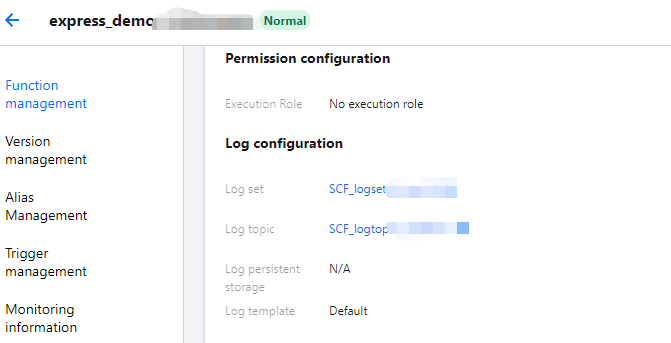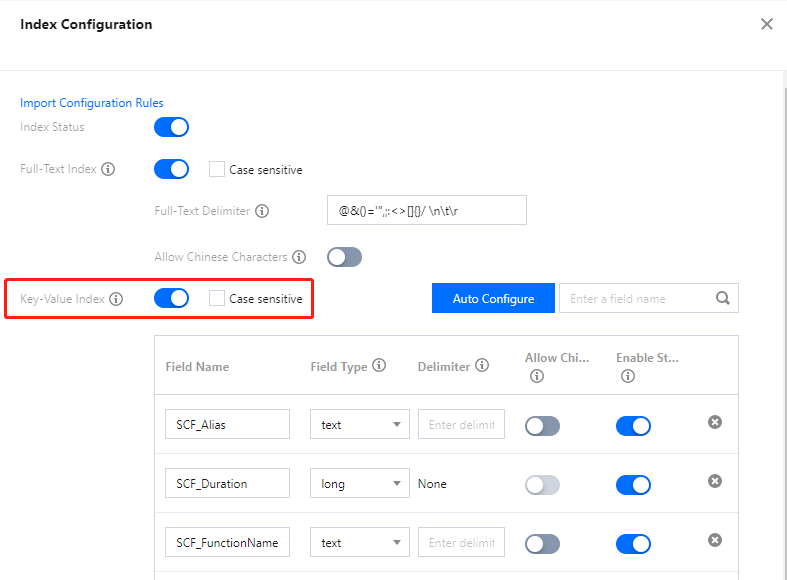- Release Notes and Announcements
- User Guide
- Product Introduction
- Purchase Guide
- Getting Started
- User Guide
- Quota Management
- Managing Functions
- Web Function Management
- Log Management
- Concurrence Management
- Trigger Management
- Version Management
- Alias Management
- Permission Management
- Managing Monitors and Alarms
- Network Configuration
- Layer Management
- Execution Configuration
- Extended Storage Management
- DNS Caching Configuration
- Triggers
- Development Guide
- Developer Tools
- Code Development
- Web Framework Development
- Deploying Framework on Command Line
- Quickly Deploying Egg Framework
- Quickly Deploying Express Framework
- Quickly Deploying Flask Framework
- Quickly Deploying Koa Framework
- Quickly Deploying Laravel Framework
- Quickly Deploying Nest.js Framework
- Quickly Deploying Next.js Framework
- Quickly Deploying Nuxt.js Framework
- Quickly Deploying Django Framework
- Best Practice
- Overview
- Solutions with Tencent Cloud Services
- Business Development
- ServerlessFramework Practices
- API Gateway
- TRTC Practices
- COS Practices
- CKafka Practice
- CLS
- CLB Practice
- MPS
- CDN
- CDWPG
- VOD
- SMS
- ES
- Scheduled Task
- Video Processing
- Success Stories
- API Documentation
- History
- Introduction
- API Category
- Making API Requests
- Trigger APIs
- Function APIs
- Invoke
- UpdateFunctionConfiguration
- UpdateFunctionCode
- ListFunctions
- GetFunctionLogs
- GetFunction
- DeleteFunction
- CreateFunction
- CopyFunction
- PublishVersion
- ListVersionByFunction
- GetFunctionAddress
- DeleteAlias
- UpdateAlias
- ListAliases
- GetAlias
- CreateAlias
- PutTotalConcurrencyConfig
- PutReservedConcurrencyConfig
- PutProvisionedConcurrencyConfig
- GetReservedConcurrencyConfig
- GetProvisionedConcurrencyConfig
- DeleteReservedConcurrencyConfig
- DeleteProvisionedConcurrencyConfig
- UpdateFunctionEventInvokeConfig
- GetFunctionEventInvokeConfig
- InvokeFunction
- GetRequestStatus
- Namespace APIs
- Layer Management APIs
- Async Event Management APIs
- Other APIs
- Data Types
- Error Codes
- Function and Layer Status Description
- SDK Documentation
- FAQs
- Related Agreement
- Contact Us
- Glossary
- Release Notes and Announcements
- User Guide
- Product Introduction
- Purchase Guide
- Getting Started
- User Guide
- Quota Management
- Managing Functions
- Web Function Management
- Log Management
- Concurrence Management
- Trigger Management
- Version Management
- Alias Management
- Permission Management
- Managing Monitors and Alarms
- Network Configuration
- Layer Management
- Execution Configuration
- Extended Storage Management
- DNS Caching Configuration
- Triggers
- Development Guide
- Developer Tools
- Code Development
- Web Framework Development
- Deploying Framework on Command Line
- Quickly Deploying Egg Framework
- Quickly Deploying Express Framework
- Quickly Deploying Flask Framework
- Quickly Deploying Koa Framework
- Quickly Deploying Laravel Framework
- Quickly Deploying Nest.js Framework
- Quickly Deploying Next.js Framework
- Quickly Deploying Nuxt.js Framework
- Quickly Deploying Django Framework
- Best Practice
- Overview
- Solutions with Tencent Cloud Services
- Business Development
- ServerlessFramework Practices
- API Gateway
- TRTC Practices
- COS Practices
- CKafka Practice
- CLS
- CLB Practice
- MPS
- CDN
- CDWPG
- VOD
- SMS
- ES
- Scheduled Task
- Video Processing
- Success Stories
- API Documentation
- History
- Introduction
- API Category
- Making API Requests
- Trigger APIs
- Function APIs
- Invoke
- UpdateFunctionConfiguration
- UpdateFunctionCode
- ListFunctions
- GetFunctionLogs
- GetFunction
- DeleteFunction
- CreateFunction
- CopyFunction
- PublishVersion
- ListVersionByFunction
- GetFunctionAddress
- DeleteAlias
- UpdateAlias
- ListAliases
- GetAlias
- CreateAlias
- PutTotalConcurrencyConfig
- PutReservedConcurrencyConfig
- PutProvisionedConcurrencyConfig
- GetReservedConcurrencyConfig
- GetProvisionedConcurrencyConfig
- DeleteReservedConcurrencyConfig
- DeleteProvisionedConcurrencyConfig
- UpdateFunctionEventInvokeConfig
- GetFunctionEventInvokeConfig
- InvokeFunction
- GetRequestStatus
- Namespace APIs
- Layer Management APIs
- Async Event Management APIs
- Other APIs
- Data Types
- Error Codes
- Function and Layer Status Description
- SDK Documentation
- FAQs
- Related Agreement
- Contact Us
- Glossary
NoteIf your function was created before January 29, 2021 and has not been migrated, but you want to use more log analysis features, deliver function invocation logs to CLS as instructed in Log Delivery Configuration (Legacy).
SCF was fully connected to Tencent Cloud CLS starting from January 29, 2021. After then, the invocation logs of newly created functions will be delivered to CLS, and logs can be output in real time. The existing functions are gradually migrated by regions. For more information, see SCF Log Service Change Notification.
This document describes the two log delivery methods of default delivery and custom delivery provided by SCF and how to configure them.
Permission Description
To view the logs normally, ensure that the sub-account at least has the read-only permission of CLS QcloudCLSReadOnlyAccess. For how the root account grant permissions for the sub-account, see Authorization Management.
Restrictions
Delivering function invocation logs to CLS has the following limits:
- The maximum amount of logs printed within 5 seconds for each request is 1 MB.
- The maximum number of logs printed within 5 seconds for each request is 5000.
- The maximum length of each log is 8 KB, and excessive parts will be discarded.
Directions
Default delivery
When creating a function, if you don't specify the destination topic for log delivery, the default log delivery capability will be used. For default log delivery, SCF will activate the CLS service for you and deliver the function invocation logs to the log topic under the SCF-specific logset. The SCF-specific logset and log topic are prefixed with SCF_logset and SCF_logtopic respectively, and will be created automatically if they do not exist. Function invocation logs will be retained for 7 days by default, and you can view and manage them on the CLS console.
Note:
- CLS is billed separately, and the SCF-specific log topic will consume the free tier of CLS. For more information, see Billing Overview.
- To ensure the proper display of logs in the SCF console, SCF-specific log topics do not support modifying the log index configuration. To customize the index configuration, configure the function log topic as instructed in Custom delivery below.
Configuring CLS
- Log in to the SCF console and select Functions on the left sidebar.
- Select the region and namespace where to create a function at the top of the page and click Create to enter the function creation process.
- In Log configuration, select Default as shown below:

- Click Complete. You can view the log configuration in Function management > Function configuration as shown below:

Viewing and managing logs
You can click the logset ID in Log Configuration in Function Configuration to enter the CLS console to view and manage logs. The SCF-specific logset is marked with the word SCF in the CLS console. If you need to persistently store, deliver, or consume logs or monitor and set alarms on log content, you can complete the configuration in the CLS console.
Custom delivery
When creating a function, if you need to specify the destination log topic to deliver function invocation logs, you can use the custom log delivery capability. Before using this capability, you should make sure that the CLS service has been activated.
Creating logset and log topic
Log in to the CLS console and create a log topic. This document uses the creation of the SCF-test log topic in Guangzhou as an example as shown below:
Note:For the logset region, select the region where the SCF service is located. Cross-region log push is not supported currently.
Configuring CLS
- Log in to the SCF console and select Functions on the left sidebar.
- Select the region where to create a function at the top of the page and click Create to enter the function creation process.
- In Log configuration, select Custom and select the log topic already created for this function. This document uses
SCF-testas an example as shown below:
- Click Confirm.
Configuring indexes
Log search depends on the index configuration of the log topic. SCF will automatically complete the index configuration when you create a function. If the index is abnormal and logs cannot be viewed properly, configure the index in the following steps:
- Log in to the SCF console and select Functions on the left sidebar.
- On the Function Service list page, select the name of the function whose index is abnormal to enter the Function Management page.
- On the Log Query tab, select Index Configuration in Advanced Retrieval as shown below:

- On the Index configuration page, enable Index status and Key-value index as shown below:

This configuration method is only valid for scenarios where there are function invocation logs in the log topic; otherwise, manually configure the key-value index by referring to the table below.Field Name Field Type Description SCF_FunctionName text Function name SCF_Namespace text Function namespace SCF_StartTime long Invocation start time SCF_LogTime long Log generation time SCF_RequestId text Request ID SCF_Duration long Function execution duration SCF_Alias text Alias SCF_Qualifier text Version SCF_MemUsage double Function runtime memory SCF_Level text Log4J log level. Default value: INFO SCF_Message text Log content SCF_Type text Log type. Platform: Platform log; Custom: User log SCF_StatusCode long Status code of function execution SCF_RetryNum long Number of retries
To ensure the display effect of the logs in the SCF console, toggle on Enable Statistics for the field in the key-value index configuration:
5. After configuring the index, click OK.

 Yes
Yes
 No
No
Was this page helpful?